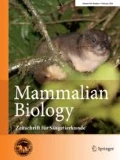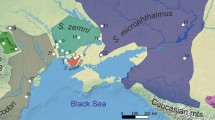Abstract
The Anatolian and the Lesser blind mole rats (Nannospalax xanthodon and N. leucodon) are widely distributed in Anatolia and Thrace and feature remarkable diversity of chromosomal races. The evolutionary relationship among various cytotypes has not been fully resolved, and little is known about the genetic diversity at the population level. Traditionally, N. xanthodon is divided into Western and Central Anatolian phylogenetic clades, but the inclusion of particular cytotypes into one or the other clade still causes controversy, and the relationship of N. leucodon from Thrace to other Turkish populations is not known. We genotyped 67 and 62 individuals, sampled across Western Turkey, respectively at one mtDNA (1048 bp long fragment of cyt b) and ten highly polymorphic microsatellite markers. The population genetic structure was analyzed (i) in respect to previously assigned karyotype (cytotypes 2n = 38, 50, 52, 56 and 60 of N. xanthodon and 2n = 56 of N. leucodon) and geographic locality data, and (ii) without assuming any prior grouping. Both the phylogeny constructed from the cyt b sequence and the population structure revealed by the microsatellite genotyping revealed the presence of two major clades. The first included the Western Anatolian populations of N. xanthodon (cytotypes 2n = 38, 2n = 50 and 2n = 52), but also N. leucodon from Thrace (2n = 56). The second clade included the Central Anatolian populations of N. xanthodon with cytotypes 2n = 56 and 2n=60. These findings support and refine the previously suggested relationships between 2n = 38, Thracian N. leucodon and 2n = 60 (Hadid et al., 2012). We also revealed higher genetic diversity, particularly within cytotype 2n = 38 (race anatolicus), and stronger population structuring within the Western Anatolian clade. In contrast, the microsatellite genotypes of two races in Central Anatolian clade (2n = 60 and 2n = 56 from Manisa province), showed less diversity and weaker population structure.
Similar content being viewed by others
References
Archer, F.I., Adams, P.E., Schneiders, B.B., 2017. Stratag: An R Package for Manipulating, summarizing and analysing population genetic data. Mol.Ecol. Res. 17 (2), 5–11, https://doi.org/10.1111/1755-0998.12559.
Arslan, A., Kryštufek, B., Matur, F., Zima, J., 2016. Review of chromosome races in blind mole rats (Spalax and Nannospalax). Folia Zool. 65, 249–301, https://doi.org/10.25225/fozo.v65.i4.al.2016.
Bryja, J., Konvičková, H., Bryjová, A., Mikula, O., Makundi, R., Chitaukali, W.N., Sumbera, R., 2018. Differentiation underground: Range-wide multilocus genetic structure of the silvery mole-rat does not support current taxonomy based on mitochondrial sequences. Mamm. Biol. 93, 82–92, https://doi.org/10.1016/J.MAMBIO.2018.08.006.
Darriba, D., Taboada, G.L., Doallo, R., Posada, D., 2012. jModelTest 2: more models, new heuristics and parallel computing. Nat. Methods 9, 772, https://doi.org/10.1038/nmeth.2109.
Dobigny, G., Britton-Davidian, J., Robinson, T.J., 2017. Chromosomal polymorphism in mammals: an evolutionary perspective. Biol. Rev. 92, 1–21, https://doi.org/10.1111/brv.12213.
Evanno, G., Regnaut, S., Goudet, J., 2005. Detecting the number of clusters of individuals using the software structure: a simulation study. Mol. Ecol. 14, 2611–2620, https://doi.org/10.1111/j.1365-294X.2005.02553.x.
Falush, D., Stephens, M., Pritchard, J.K., 2003. Inference of population structure using multilocus genotype data: linked loci and correlated allele frequencies. Genetics 64, 1567-LP-1587.
Felsenstein, J., 1985. Phytogenies and the comparative method. Am. Nat. 125, 1–15, https://doi.org/10.1086/284325.
Goudet, J., 2005. hierfstat, a package for R to compute and test hierarchical F-statistics. Mol. Ecol. Notes 5, 184–186, https://doi.org/10.1111/j.1471-8286.2004.00828.x.
Guichoux, E., Lagache, L., Wagner, S., Chaumeil, P.P.L., Lepais, O., Lepoittevin, C., Malausa, T., Revardel, E.F.S., Petit, R.J., 2011. Current trends in microsatellite genotyping. Mol. Ecol. Resour. 11, 591–611, https://doi.org/10.1111/j.1755-0998.2011.03014.x.
Guindon, S., Gascuel, O., 2003. A Simple, Fast and Accurate Method to estimate large phytogenies by maximum-likelihood. Syst. Biol. 52, 696–704.
Guindon, S., Dufayard, J.F., Lefort, V., Anisimova, M., Hordijk, W., Gascuel, O., 2010. New algorithms and methods to estimate maximum-likelihood phytogenies: Assessing the Performance of PhyML 3.0. Syst. Biol. 59, 307–321, https://doi.org/10.1093/sysbio/syq010.
Hadid, Y., Németh, A., Snir, S., Pavlíček, T., Csorba, G., Kázmér, M., Major, Á., Mezhzherin, S., Rusin, M., Coşkun, Y., Nevo, E., 2012. Is evolution of blind mole rats determined by climate oscillations? PLoS One 7, e30043, https://doi.org/10.1371/journal.pone.0030043.
Hedrick, P.W., 2005. A standardized genetic differentiation measure. Evolution (N.Y) 59, 1633–1638, https://doi.org/10.1111/j.0014-3820.2005.tb01814.x.
Ivanitskaya, E., Sozen, M., Rashkovetsky, L., Matur, F., Nevo, E., 2008. Discrimination of 2n = 60 Spalax leucodon cytotypes (Spalacidae, Rodentia) in Turkey by means of classical and molecular cytogenetic techniques. Cytogenet. Genome Res. 122, 139–149, https://doi.org/10.1159/000163091.
Jakobsson, M., Rosenberg, N.A., 2007. CLUMPP: a cluster matching and permutation program for dealing with label switching and multimodality in analysis of population structure. Bioinformatics 23, 1801–1806, https://doi.org/10.1093/bioinformatics/btm233.
Jombart, T., 2008. adegenet: a R package for the multivariate analysis of genetic markers. Bioinformatics 24, 1403–1405, https://doi.org/10.1093/bioinformatics/btn129.
Kandemİr, İ., Sözen, M., Matur, F., Kankoiloiç, T., Martínková, N., Çolak, F., Özkurt Ö, S., Çolak, E., 2012. Phytogeny of species and cytotypes of mole rats (Spalacidae) in Turkey inferred from mitochondrial cytochrome b gene sequences. Folia Zool 61, 25–33, https://doi.org/10.25225/fozo.v61.i1.a5.2012.
Kankoiloiç, T., Kankoiloiç, T., Çolak, R., Çolak, E., Karataş, A., 2007. Karyological comparison of populations of the Spalax leucodon Nordmann, superspecies (Rodentia: Spalacidae) in Turkeyl. Zool. Middle East 42, 15–24, https://doi.org/10.1080/09397140.2007.10638242.
Kankoiloiç, T., Kankoiloiç, T., Sözen, M., Çolak, E., 2015. Allozyme variations in Anatolian populations and cytotypes of the blind mole rats (Nannospalax). Biochem. Syst. Ecol. 59, 126–134, https://doi.org/10.1016/J.BSE.2014.12.021s.
Karanth, K.P., Avivi, A., Beharav, A., Nevo, E., 2004. Microsatellite diversity in populations of blind subterranean mole rats (Spalax ehrenbergi superspecies) in Israel: speciation and adaptation. Biol. J. Linn. Soc. 83, 229–241, https://doi.org/10.1111/j.1095-8312.2004.00384.x.
Kraemer, P., Gerlach, G., 2017. Demerelate: calculating interindividual relatedness for kinship analysis based on codominant diploid genetic markers using R. Mol. Ecol. Resour. 17, 1371–1377, https://doi.org/10.1111/1755-0998.12666.
Kryštufek, B., Vohralík, V., 2009. Mammals of Turkey and Cyprus. Rodentia II: Cricetinae, Muridae, Spalacidae, Calomyscidae, Capromyida, Hystricidae, Castoridae. Annales Majora. Annales Majora, Koper.
Kryštufek, B., Ivanitskaya, E., Arslan, A., Arslan, E., Bužan, E.V., 2012. Evolutionary history of mole rats (Genus Nannospalax) inferred from mitochondrial cytochrome b sequence. Biol. J. Linn. Soc. 105, 446–455, https://doi.org/10.1111/J.1095-8312.2011.01795.X.
Leberg, P.L., 2008. Estimating allelic richness: Effects of sample size and bottlenecks. Mol. Ecol. 11, 2445–2449, https://doi.org/10.1046/j.1365-294X.2002.01612.x.
Lecompte, E., Brouat, C., Duplantier, J.M., Galan, M., Granjon, L., Loiseau, A., Mouline, K., Cosson, J.F., 2005. Molecular identification of four cryptic species of Mastomys (Rodentia, Murinae). Biochem. Syst. Ecol. 33, 681–689, https://doi.org/10.1016/J.BSE.2004.12.015.
Legendre, P., Fortin, M.J., 1989. Spatial pattern and ecological analysis. Vegetatio 80, 107–138, https://doi.org/10.1007/BF00048036.
Matur, F., Çolak, F., Ceylan, T., Sevindik, M., Sözen, M., 2013. Chromosomal evolution of the genus Nannospalax (Palmer (Rodentia, Muridae) from western Turkey. Turkish J. Zool., 37, https://doi.org/10.3906/zoo-1208-25.
Meirmans, P.G., 2006. Using the amova framework to estimate a standardized genetic differentiation measure, Evolution. Evolution (N.Y) 60, 2399–2402, https://doi.org/10.1111/j.0014-3820.2006.tb01874.x.
Michaux, J., Chevret, P., Filippucci, M.G., Macholan, M., 2002. Phylogeny of the genus Apodemus with a special emphasis on the subgenus Sylvaemus using the nuclear IRBP gene and two mitochondrial markers: cytochrome b and 12S rRNA. Mol. Phylogenet. Evol. 23, 123–136, https://doi.org/10.1016/S1055-7903(02)00007-6.
El Mousadik, A., Petit, R.J., 1996. High level of genetic differentiation for allelic richness among populations of the argan tree [Argania spinosa (L.) Skeels] endemic to Morocco. Theor. Appl. Genet. 92, 832–839, https://doi.org/10.1007/BF00221895.
Nevo, E., Filippucci, M.G., Redi, C., Korol, A., Beiles, A., 1994. Chromosomal speciation and adaptive radiation of mole-rats in Asia minor correlated with increased ecological stress. Proc. Natl. Acad. Sci. U. S. A. 91, 8160–8164.
Page, R.D.M., 1996. TreeView: An Application to Display Phylogenetic Trees on Personal Computers. Comput. Ap (12), 357–358, SRC-Baidu Scholar FG-0.
Rambaut, A., Drummond, A.J., Xie, D., Baele, G., Suchard, M.A., 2018. Posterior summarization in Bayesian phylogenetics using tracer 1. 7. Syst. Biol. 67, 901–904, https://doi.org/10.1093/sysbio/syy032.
Ronquist, F., Teslenko, M., van der Mark, P., Ayres, D.L., Darling, A., Höhna, S., Larget, B., Liu, L., Suchard, M.A., Huelsenbeck, J.P., 2012. MrBayes 3. 2: Efficient bayesian phylogenetic önference and model choice across a large model space. Syst. Biol. 61, 539–542, https://doi.org/10.1093/sysbio/sys029.
Rosas, U., Barton, N.H., Copsey, L., Barbier de Reuille, P., Coen, E., 2010. Cryptic variation between species and the basis of hybrid performance. PLoS Biol. 8, el000429, https://doi.org/10.1371/journal.pbio.1000429.
Sözen, M., Çolak, F., Sevindik, M., Matur, F., 2015. Two new cytotypes and additional karyological records for blind mole rats, Nannospalax xanthodon and n. ehrenbergi (Mammalia, Rodentia) in Turkey. Folia Zool, 64.
Sozen, M., Matur, F., Colak, E., Ozkurt, S., Karatas, A., 2006. Some karyological records and a new chromosomal form for Spalax (Mammalia: Rodentia) in Turkey. Folia Zool 55, 247–256.
Stamatakis, A., 2014. RAxML Version 8: A Tool for Phylogenetic analysis and post-analysis of large phytogenies. Bioinformatics 30 (9). Oxford University Press, pp. 1312–1313, https://doi.org/10.1093/bioinformatics/btu033.
Šumbera, R., Krásová, J., Lavrenchenko, L.A., Mengistu, S., Bekele, A., Mikula, O., Bryja, J., 2018. Ethiopian highlands as a cradle of the African fossorial root-rats (genus Tachyoryctes), the genetic evidence. Mol. Phylogenet. Evol. 126, 105–115, https://doi.org/10.1016/J.YMPEV.2018.04.00.
Swofford, D.L., 2002. PAUP* Phylogenetic Analysis using parsimony (* and other methods). Version 4. Sinauer Associates, Massachusetts.
Tamura, I., Stecher, G., Peterson, D., Filipski, A., Kumar, S., 2013. MEGA6: Molecular Evolutionary Genetics Analysis Version 6.0. Mol. Biol. Evol. 30, 2725–2729, https://doi.org/10.1093/molbev/mst197.
Wahrman, J., Goitein, R., Nevo, E., 1969. Mole rat Spalax: Evolutionary significance of chromosome variation. Science 164, 82–84, https://doi.org/10.1126/SCIENCE.164.3875.82.
Warren, D.L., Geneva, A.J., Lanfear, R., Rosenberg, M., 2017. RWTY (R We There Yet): An R Package for Examining convergence of bayesian phylogenetic analyses. Mol. Biol. Evol. 34, 1016–1020, https://doi.org/10.1093/molbev/msw279.
Winter, D.J., 2012. mmod: an R library for the calculation of population differentiation statistics. Mol. Ecol. Resour. 12, 1158–1160, https://doi.org/10.1111/j.1755-0998.2012.03174.x.
Author information
Authors and Affiliations
Corresponding author
Rights and permissions
About this article
Cite this article
Matur, F., Yanchukov, A., Çolak, F. et al. Two major clades of blind mole rats (Nannospalax sp.) revealed by mtDNA and microsatellite genotyping in Western and Central Turkey. Mamm Biol 94, 38–47 (2019). https://doi.org/10.1016/j.mambio.2018.11.004
Received:
Accepted:
Published:
Issue Date:
DOI: https://doi.org/10.1016/j.mambio.2018.11.004




